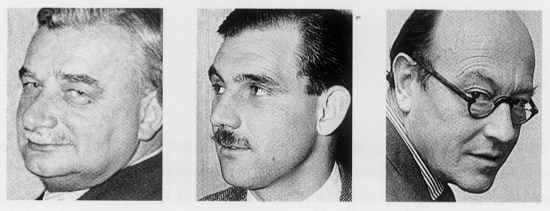CDP – the original new media agency

Collett, Dickenson and Pearce in all their venerable moustache wearing glory
BBC 4 have a wonderful documentary on advertising they wheel out from time to time. It’s called The Men from the Agency a looks at the contribution to popular culture (largely art and film) of four people who all worked together at CDP in the late ’60s – Charles Saatchi, David Putnam and Alan Parker.
One of the most moving parts of the film is effectively an apology by David Putnam for the loose approach to ethics that dominated the industry right up to the ’90s and revolved around the idea that it the product was legal it was legitimate to advertise it. This apology is significant because CDP were just as successful at selling fags as they were in selling everything else.
Of course today CDP is a shadow of its former self, but in its hey day it changed British advertising beyond recognition leaving a legacy that remained unchallenged until the likes of HHCL, St Lukes and Mother arrived on the scene 30 years later.
They constructed from scratch a definitively British approach to advertising that picked up the philosophy and approach of Bernbach and reinterpreted it for a Britain undergoing extraordinary social, political and economic change. For many people they and their descendants, agencies like Saatchis and Lowes, kept the Bernbach candle burning when it was almost completely extinguished in the US.
And in doing so they tamed two revolutionary new media – TV and colour print.
Though commercial TV had existed in the UK since the late 50s, CDP that made it work in an idiosyncratically British way – dispensing with sales and production techniques appropriated from America and learning a new approach better suited to British sensibilities – often experimenting by shooting commercials in the basement themselves.
Somewhat surprisingly quality colour print was even more of an emergent media in the late 60s than TV, pioneered by the Sunday Times Magazine which increasingly became a showcase for Collett’s work – for Stella Artois, Harveys Bristol Cream and of course Olympus.
CDP ‘got it’, in as much as they understood the way people were changing and people’s media landscape was changing as affluence rose and class structures declined in post war Britain.
It rather reminds me that, while many obsess that advertising is somehow wedded to specific media, in truth it is far more adaptable – jumping from media to media as their fortunes wax and wane in the consumer’s lives and hearts.
And it often takes a new generation of agencies to achieve these paradigm shifts in the business with many established names and false hopes (those agencies that start up in the dying years of the old order but don’t really get it) unable to adjust.
Just as in the late ’60s advertising will emerge from the challenges that it faces at the moment. But it will emerge with a different set of agencies, skills and business models than those, though challenged in the ’90s, that remain very much the same as when Saatchi, Putman and Parker left CDP.
And here is the seminal Hovis ad – it seemed rude not to.
And this book (as endorsed by the scary Paul Colman in the comments) tells the story rather better than I have:
Discover more from
Subscribe to get the latest posts sent to your email.

Its a really interesting programme.
I hope its repeated soon.
You ever see the CDP book that the agency put together a few years ago? (I think to celebrate an anniversary or something.) A collection of anecdotes and many of the utterly stunning ads they have produced, right up to the rubbish Honda ones.
As a client I often use it as a tool to remind myself how high the bar should be.
Its wonderful – I will try and provide a link. Rather sad at the end though when they were pretending it was still all OK.
Notice that they still have Yakult in their case studies and the work they did.
Mind you we still bang on about Tango and Pot Noodle.
my wife came home after another intersting day at the local brewer and wanted to hear my thoughts on their sponsorship agency CDP.
Strange but true, and very sad indeed.
That’s the one.
(And you’re hardly one to go on about scary, you prickly bugger.)
I love your definition of “get it” … “[understanding] … the way people were changing and people’s media landscape was changing”.
We need more of that.